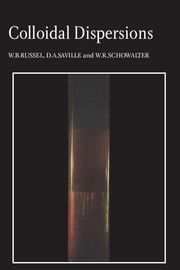Book contents
- Frontmatter
- ACKNOWLEDGEMENTS
- Contents
- Preface
- Units and physical constants
- Mathematical symbols
- 1 A Survey of Colloidal Dispersions
- 2 Hydrodynamics
- 3 Brownian Motion
- 4 Electrostatics
- 5 Dispersion forces
- 6 Forces due to soluble polymer
- 7 Electrokinetic phenomena
- 8 Electrostatic stabilization
- 9 Polymeric stabilization
- 10 Equilibrium phase behavior
- 11 Particle capture
- 12 Sedimentation
- 13 Diffusion
- 14 Rheology
- Appendix A Measured properties
- Appendix B Vector and tensor notation
- Author index
- Subject index
1 - A Survey of Colloidal Dispersions
Published online by Cambridge University Press: 05 August 2012
- Frontmatter
- ACKNOWLEDGEMENTS
- Contents
- Preface
- Units and physical constants
- Mathematical symbols
- 1 A Survey of Colloidal Dispersions
- 2 Hydrodynamics
- 3 Brownian Motion
- 4 Electrostatics
- 5 Dispersion forces
- 6 Forces due to soluble polymer
- 7 Electrokinetic phenomena
- 8 Electrostatic stabilization
- 9 Polymeric stabilization
- 10 Equilibrium phase behavior
- 11 Particle capture
- 12 Sedimentation
- 13 Diffusion
- 14 Rheology
- Appendix A Measured properties
- Appendix B Vector and tensor notation
- Author index
- Subject index
Summary
Colloidal phenomena
Colloidal particles dispersed in liquids exhibit astonishing properties. Dispersions such as the colloidal gold sol prepared by Faraday (1791 – 1867) over a century ago can persist almost indefinitely, yet the addition of salt would cause rapid, irreversible flocculation. In fact, for many dispersions the physical state, i.e. the stability or phase behavior, can be altered dramatically by modest changes in composition. This complex behavior stems from the different forces that act among the particles, determining their spatial distribution and governing the dynamics. Brownian motion and dispersion forces (arising from London–van der Waals attraction) would flocculate Faraday's gold sol were it not for electrostatic repulsion between the particles. The addition of salt increases the concentration of ions screening the surface charge, suppressing repulsion and allowing flocculation. Doublets and more complicated structures formed during flocculation have long lifetimes, since Brownian motion is too weak to overcome the strong attractive force between particles near contact. Indeed, removal of the salt does not usually lead to spontaneous redispersion, so mechanical means must be used.
Another type of transformation occurs when ions are removed from electrostatically stabilized systems. Polymer latices in an electrolyte solution are milky-white fluids, but dialysis eliminates the ions and leads to iridescence owing to Bragg diffraction of visible light from an ordered structure (Fig. 1.1). Here the absence of screening allows long-range electrostatic repulsion to induce a disorder-order phase transition.
- Type
- Chapter
- Information
- Colloidal Dispersions , pp. 1 - 20Publisher: Cambridge University PressPrint publication year: 1989
- 3
- Cited by



